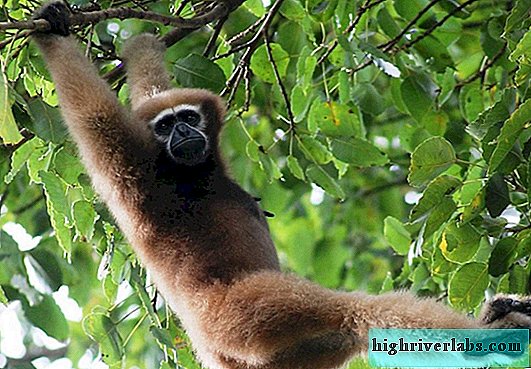Hulok is a representative of the Gibbon family. It forms a separate genus.
There are 2 types of huloks: eastern and western. The habitat of these animals is Assam in India, Yunnan in China, east of Bangladesh and northeast of Myanmar. The preferred habitat is rainforest.
Huloks jump from one branch to another, before that swinging in their arms. Primates are active during the day. Hulok couples are monogamous.
 Western Hulock (Hoolock hoolock).
Western Hulock (Hoolock hoolock).Western hulok
Western Huloks live in Bangladesh, western Assam, Myanmar, west of the Chinduin River. There are no sex differences in weight and size. The body length of the hulok is 60-90 cm. The weight of an adult varies from 6 to 9 kg. The color of females and males is different. Males have black fur. There is a white streak above their eyes.
Females are dark brown, their chest and neck are darker. On the muzzle there is a white strip, which passes so that it forms a kind of mask. Offspring are born with light gray fur. Then the fur darkens and at 6 months all young individuals are black, regardless of gender. Upon reaching 4 years, females begin to lighten.
Eastern hulok
 Eastern Hulok (Hoolock leuconedys).
Eastern Hulok (Hoolock leuconedys).These primates live in the east of Assam, in parts of Arunachal Pradesh, Myanmar, east of the Chinduin River and in the southwest of Yunnan in China. The males have black fur; the females have dark yellow to light brown fur. Males above the eyes have white stripes that are not interconnected. The body length of these primates is about 80 cm. The average weight of an adult is 6.5 kg.
Reproduction and longevity
 Female Western Hulok.
Female Western Hulok.The duration of pregnancy in huloks is 7.5 months. A baby is born with light fur. In eastern huloks, at 6 months old, the fur of the males turns black, and the females acquire a dark yellow color. Such they remain until the end of life. Females feed the young with milk for 2 years. Huloks become sexually mature at the age of 9. By this age, fur becomes an "adult" color. Life expectancy in the wild is about 25 years; in captivity, primates live up to 40 years.
Hulok behavior and nutrition
 Huloks are excellent poison frogs.
Huloks are excellent poison frogs.Basically, these monkeys are in the crowns of trees. Very quickly jump from branch to branch, with a maximum speed of 55 km / h. They stand perfectly on the hind limbs on tree branches. They live in families, which include a pair of males and females and their offspring until adolescence. In the family, everything is connected by family ties, there are no strangers. To tell other primates that the tree is busy, the huloks scream loudly. The diet includes fruits, leaves, flowers, shoots.
Number
 Meeting of Western and Eastern Hulok at the zoo.
Meeting of Western and Eastern Hulok at the zoo.The number of rainforests is declining and this negatively affects the number of hulok population. In the past 40 years, the number of these monkeys has decreased by 30%. At the moment, the eastern huloks are vulnerable. The situation with Western huloks is more favorable, their number has a stable acceptable level and does not cause concern among specialists.











